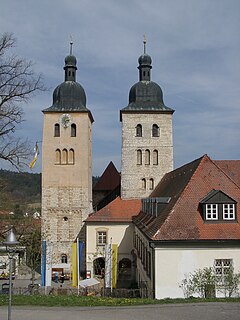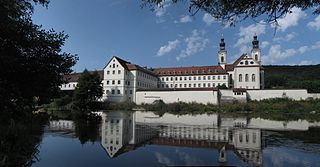
Wessobrunn Abbey was a Benedictine monastery near Weilheim in Bavaria, Germany.

Schlehdorf Abbey was originally a Benedictine monastery, later an Augustinian monastery, and is today a convent of the Missionary Dominican Sisters of King William's Town.

Beuerberg Abbey, formerly a monastery of the Augustinian Canons, is now the Monastery of the Visitation, Beuerberg, a community of the Visitandines in Eurasburg in Bavaria, Germany.

Plankstetten Abbey is a monastery of the Benedictines located between Berching and Beilngries in Bavaria, Germany. It is a member of the Bavarian Congregation of the Benedictine Confederation.

Michelfeld Abbey was a Benedictine monastery in Auerbach in der Oberpfalz in Bavaria, Germany.
St. Stephen's Abbey, Augsburg is a Benedictine monastery, formerly a house of Augustinian canonesses, in Augsburg in Bavaria, Germany.

Reichenbach Abbey is a monastery of the Brothers Hospitallers, formerly a Benedictine monastery, in Reichenbach in Bavaria, Germany.
Münsterschwarzach Abbey, is a Benedictine monastery in Germany. It is located at the confluence of the rivers Schwarzach and Main in Bavaria.

Buchau Abbey, otherwise the Imperial Abbey of Buchau, was initially a community of canonesses regular, and later a collegiate foundation of secular canonesses, in Buchau in Baden-Württemberg, Germany. The abbey was a self-ruling Imperial Estate and its abbess had seat and vote at the Imperial Diet.
Buxheim Charterhouse was formerly a monastery of the Carthusians and is now a monastery of the Salesians. It is situated in Buxheim near Memmingen in Bavaria.

Waldsassen is a town in the district of Tirschenreuth in the Upper Palatinate region of Bavaria.

The Imperial Abbey of Kaisersheim, was a Cistercian monastery in Kaisersheim, Bavaria, Germany.

St. Mang's Abbey, Füssen or Füssen Abbey was a Benedictine monastery in Füssen in Bavaria, Germany. It was founded in the 9th century, and dissolved during the post-Napoleonic secularisation of Bavaria.

Fürstenfeld Abbey is a former Cistercian monastery in Fürstenfeldbruck, Bavaria, Germany.

Oberschönenfeld Abbey is a Cistercian nunnery in Gessertshausen in Bavaria, Germany.
Ursberg Abbey is a former Premonstratensian monastery, now a convent of the Franciscan St. Joseph's Congregation, situated in the small village of Ursberg in the district of Günzburg, Bavaria.
The Obermünster, or Obermünster Abbey, Regensburg, was a collegiate house of canonesses (Frauenstift) in Regensburg, Bavaria, second only to Niedermünster in wealth and power.

Windberg Abbey is a Premonstratensian monastery in Windberg in Lower Bavaria, Germany.

Pielenhofen Abbey is a former Cistercian nunnery, in Pielenhofen in the valley of the Naab, Bavaria, Germany. It was occupied until 2010 by the Visitandines, also known as the Salesian Sisters. The Diocese of Regensburg maintains a school here.

Geisenfeld Abbey was a convent in Bavaria, Germany, in the town of Geisenfeld. It was founded in 1037 and dissolved in 1804. At one time it was one of the most prosperous convents in Bavaria.

















